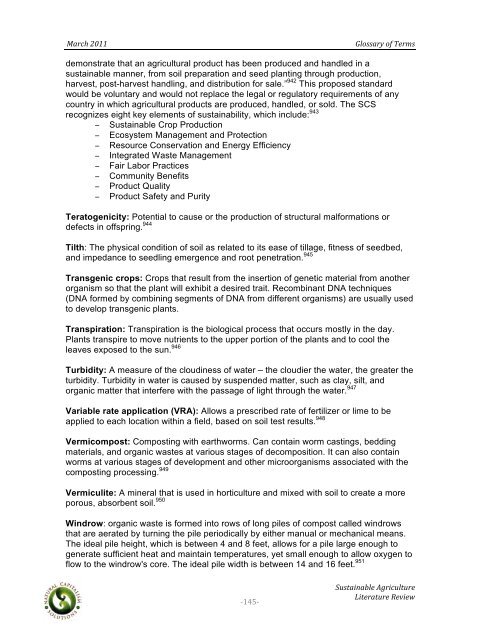Sustainable Agriculture Literature Review - Boulder County
Sustainable Agriculture Literature Review - Boulder County
Sustainable Agriculture Literature Review - Boulder County
Create successful ePaper yourself
Turn your PDF publications into a flip-book with our unique Google optimized e-Paper software.
! !!<br />
"#$%&!'())!! !!!!!!!!!!!!!!!!!!!!!!!!!!!!!!!!!!!!!!!!!!!!!!!!!!!!!!!!!!!!!!!!I/-44#$F!-J!K1$B4!<br />
demonstrate that an agricultural product has been produced and handled in a<br />
sustainable manner, from soil preparation and seed planting through production,<br />
harvest, post-harvest handling, and distribution for sale.” 942 This proposed standard<br />
would be voluntary and would not replace the legal or regulatory requirements of any<br />
country in which agricultural products are produced, handled, or sold. The SCS<br />
recognizes eight key elements of sustainability, which include: 943<br />
! <strong>Sustainable</strong> Crop Production<br />
! Ecosystem Management and Protection<br />
! Resource Conservation and Energy Efficiency<br />
! Integrated Waste Management<br />
! Fair Labor Practices<br />
! Community Benefits<br />
! Product Quality<br />
! Product Safety and Purity<br />
Teratogenicity: Potential to cause or the production of structural malformations or<br />
defects in offspring. 944<br />
Tilth: The physical condition of soil as related to its ease of tillage, fitness of seedbed,<br />
and impedance to seedling emergence and root penetration. 945<br />
Transgenic crops: Crops that result from the insertion of genetic material from another<br />
organism so that the plant will exhibit a desired trait. Recombinant DNA techniques<br />
(DNA formed by combining segments of DNA from different organisms) are usually used<br />
to develop transgenic plants.<br />
Transpiration: Transpiration is the biological process that occurs mostly in the day.<br />
Plants transpire to move nutrients to the upper portion of the plants and to cool the<br />
leaves exposed to the sun. 946<br />
Turbidity: A measure of the cloudiness of water – the cloudier the water, the greater the<br />
turbidity. Turbidity in water is caused by suspended matter, such as clay, silt, and<br />
organic matter that interfere with the passage of light through the water. 947<br />
Variable rate application (VRA): Allows a prescribed rate of fertilizer or lime to be<br />
applied to each location within a field, based on soil test results. 948<br />
Vermicompost: Composting with earthworms. Can contain worm castings, bedding<br />
materials, and organic wastes at various stages of decomposition. It can also contain<br />
worms at various stages of development and other microorganisms associated with the<br />
composting processing. 949<br />
Vermiculite: A mineral that is used in horticulture and mixed with soil to create a more<br />
porous, absorbent soil. 950<br />
Windrow: organic waste is formed into rows of long piles of compost called windrows<br />
that are aerated by turning the pile periodically by either manual or mechanical means.<br />
The ideal pile height, which is between 4 and 8 feet, allows for a pile large enough to<br />
generate sufficient heat and maintain temperatures, yet small enough to allow oxygen to<br />
flow to the windrow's core. The ideal pile width is between 14 and 16 feet. 951<br />
!<br />
"'*#"<br />
!,342#.5#6/1!78$.%3/23$1!<br />
9.21$#23$1!:1;.1
















